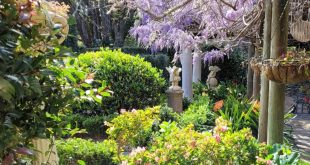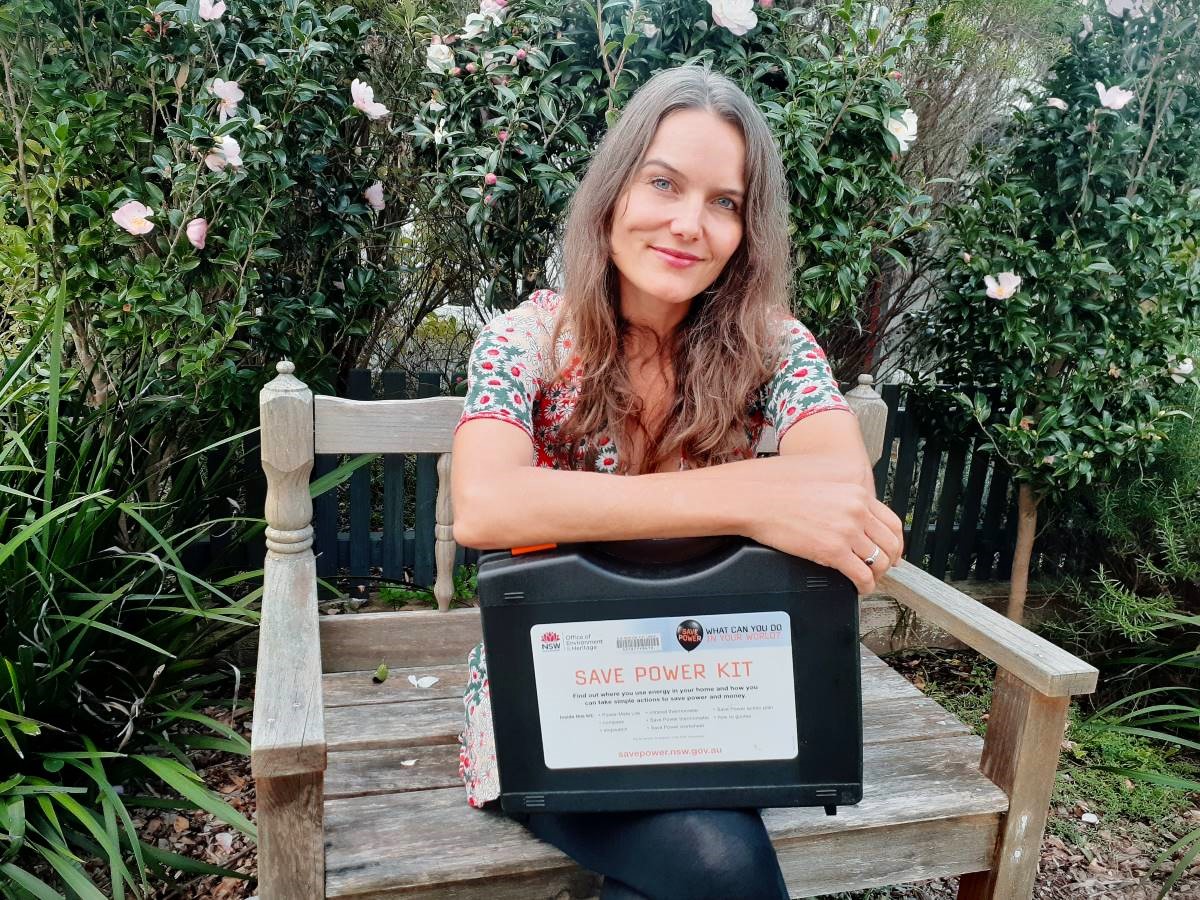
Belle Butler with a ‘My Energy and Water Saver’ kit borrowed from the library. (Photo by Nahla)
Story and photos by Belle Butler
Blue Mountains libraries now stock free-to-borrow ‘My Energy and Water Saver’ kits that Blue Mountains residents can use to assess their homes for energy and water efficiency. Belle Butler borrowed one of the kits and discovered some room for improvement in her Lawson home.
Key Points:
- Most per capita greenhouse gas emissions come from the electricity and heating needs of homes.
- The Climate Council touts energy-efficiency as one of the easiest, cheapest and fastest ways to reduce emissions.
- Borrowing a kit from a Blue Mountains Library can help you maximise your energy efficiency, cut your emissions and save on your energy bill.
Climate change is an issue so big that sometimes, as one little person on the planet, it’s hard to know what to do. And when everyday life is filled to the brim with various expectations and commitments, ‘doing’ something at all can feel like a daunting task.
However, even some small changes to your everyday habits can make a difference. Unless you are running your household on renewable energy (if you are, then kudos!), much of your greenhouse gas input will come from the electricity and heating needs of your home.
Here in Australia, most of our electricity still comes from non-renewable, polluting sources, with NSW still relying heavily on coal.
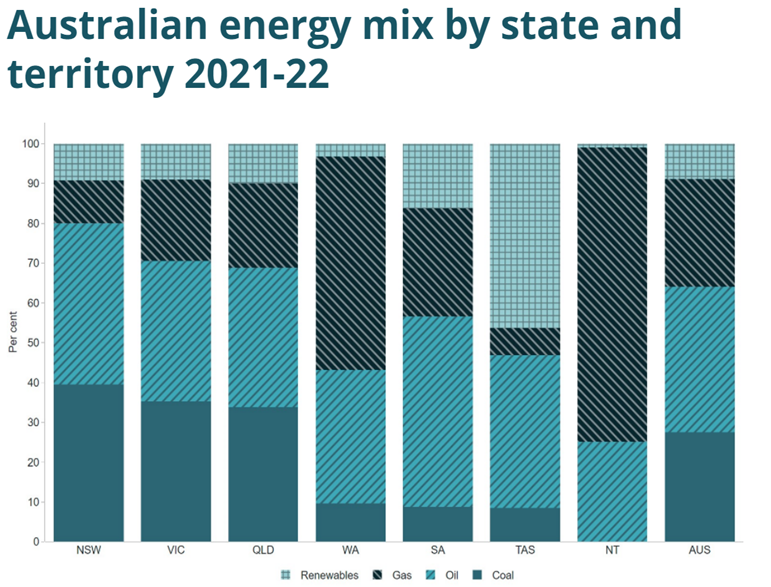
Graph of energy sources by state and territory. -from Australian Government – Department of Climate Change, Energy, the Environment and Water
Using this fuel for most of our energy needs makes us a hefty contributor to greenhouse gas emissions via these sources:
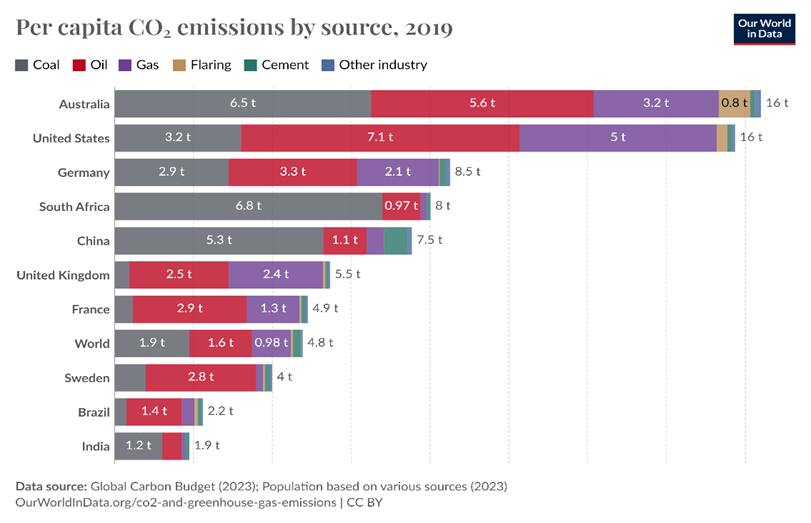
Graph by Our World in Data
This is a significant factor in our exceedingly large global contribution (per capita) to overall greenhouse gas emissions:
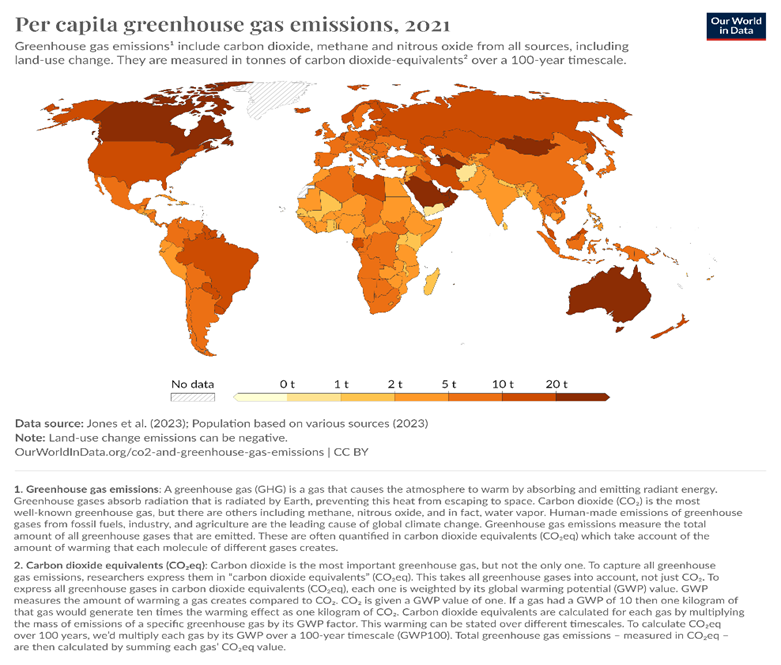
Graph by Our World in Data
These graphs present a compelling argument for renewables, but if investing in household solar isn’t an option for you right now, making changes to how you use energy can reduce your emissions (and your electricity bill). The Climate Council touts energy-efficiency as one of the easiest, cheapest and fastest ways to reduce emissions.
Test your energy efficiency
Blue Mountains City Council has now introduced ‘My Energy and Water Saver’ kits to its branch libraries, which residents can borrow free of charge. The kits contain tools and a guide on how to use them in order to identify where household reductions in power and water usage might easily be made. The kits come with the following items:
- Power Mate Lite – measures the amount of power drawn by an electrical appliance.
- Infrared Thermometer – Measures temperature of objects to find where heat is lost or gained. Great for testing windows and doors for draughts.
- Thermometer – measures air temperature including in the fridge and freezer.
- Compass – Identifies north and west facing rooms that receive the most sun.
- Stopwatch – Used to measure flow rates of showerheads and taps.
- Worksheets – Guides the user through helpful tests and allows for record-keeping of findings.
NB. The new version of the kit also includes a Thermal Imaging Camera (FLIR) which can measure radiant heat to help you prepare for future heat waves. It can also detect areas of energy loss in the home such as missing insulation, gaps in floorboards or around doors etc.
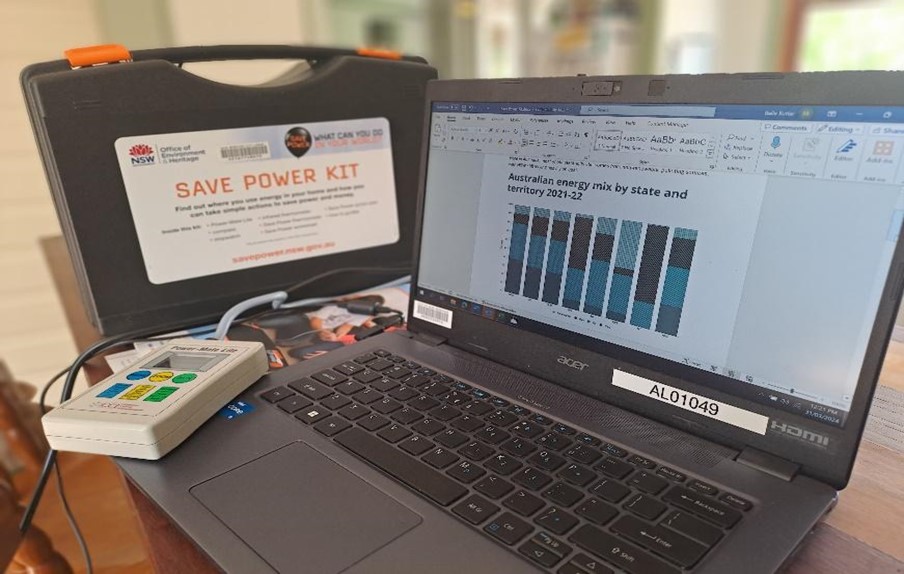
Testing out the energy consumption of my laptop while writing this article.
“Rising energy costs are a real concern for Blue Mountains residents,” said Mayor Mark Greenhill. “This kit is a simple and effective way to identify where heating or cooling might be escaping your home and make the necessary changes.
“Making your home more energy efficient is a key part of living sustainably and having an environmentally friendly lifestyle and this kit makes that process easy.”
Putting the Kit to Use
I live with my family in a draughty older Mountains home in need of some roof-work before solar panels can be installed. So we are classic candidates for this kit. Borrowing it from the library gave us an opportunity to talk to the kids about energy and water usage and then put our home to the test with some fun activities.
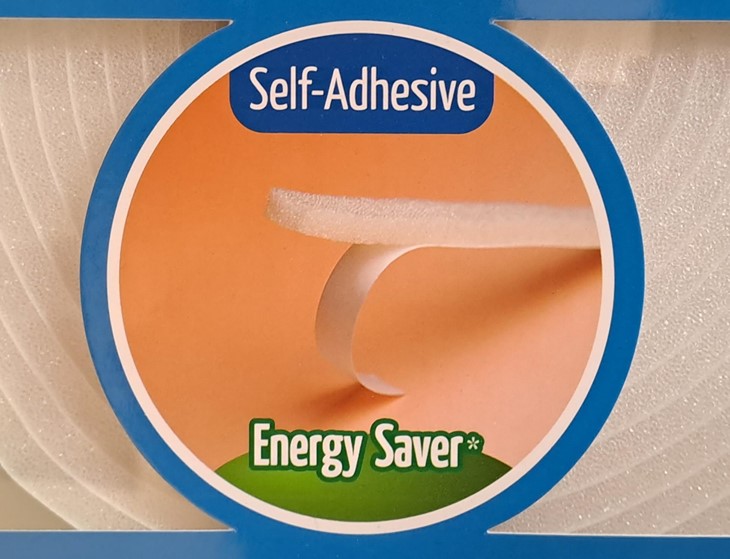
Draught tape can be purchased at hardware stores and easily applied around windows and doors to save on heating and cooling needs.
While we are probably considered more of a low-tech household, we still have the modern standards of a television and computers, and we found that we could make better choices by not leaving these devices on standby mode.
Our modest TV on standby amounts to about 50 kwh per year. Based on the emissions calculator on coolaustralia.org, that amounts to 43.5 kg Co2e (carbon dioxide equivalent, used to measure greenhouse gas emissions) each year. That seemed like a lot to me for an appliance that was just sleeping, and I wondered how many kilos of Co2e all the TVs on standby in the Blue Mountains are responsible for.
So I did a rough estimation based on the readings from my (comparatively small) TV applied to the number of dwellings in the Blue Mountains area according to the 2021 Census. If all 35,139 dwellings left one modest TV on standby for the entire year, and these households relied on the grid for their energy, these TVs would be responsible for 1,528,546.5 kg Co2e each year.
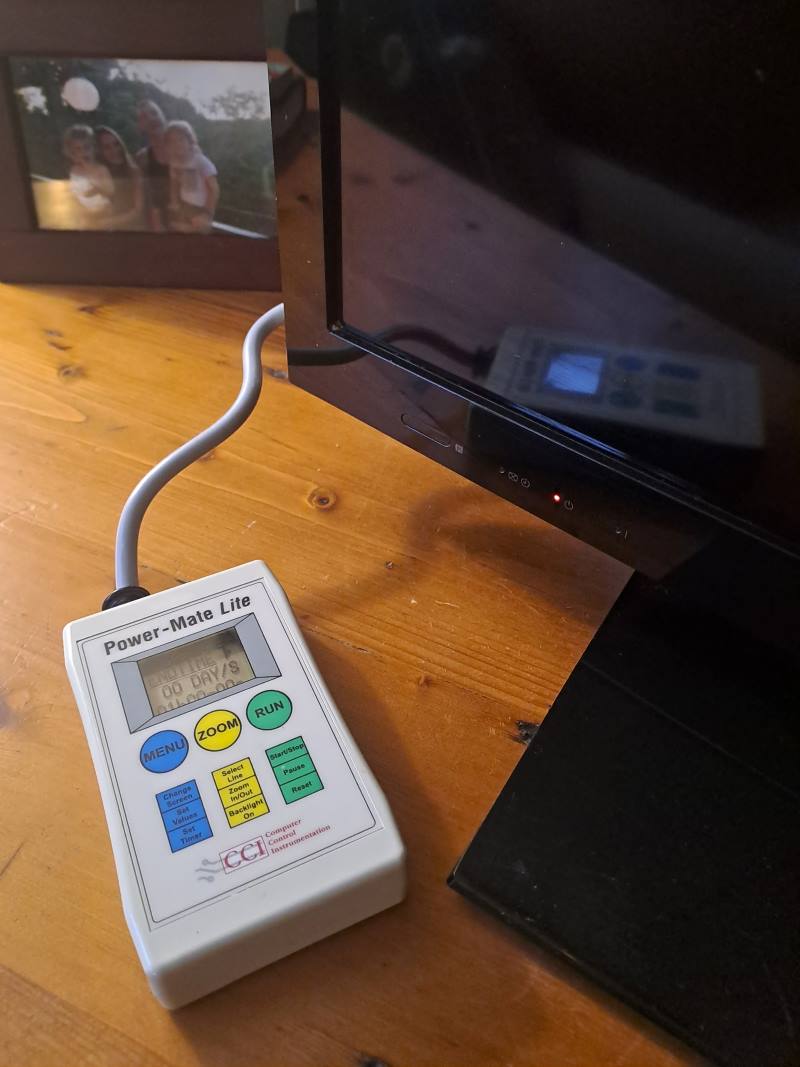
Testing the energy used by Belle’s TV while on standby
Obviously these are not official numbers. There are many variables not considered here, from size of TV and number of TVs per household, to whether households are turning off their TVs at the switch or running them partially or fully on solar energy. However, as a rough estimation, that’s a lot of pollution coming from sleeping screens in the Blue Mountains.
In another experiment, my son was able to measure how much energy is wasted when he forgets to turn off his bedside lamp for the day, after turning it on to read when he wakes up in the morning. Rough estimations on how often he does this resulted in about 1kg of Co2e emitted by a forgotten lamp each year.
We also measured the flow rate of our showerhead (below the maximum recommendation of 9 litres a minute), the temperatures of our fridge and freezer (just right), and the temperature difference between our west facing kitchen and our internal living room at 3pm on a warm autumn day: 33 degrees versus a pleasant 25 degrees. Time for double-glazing!
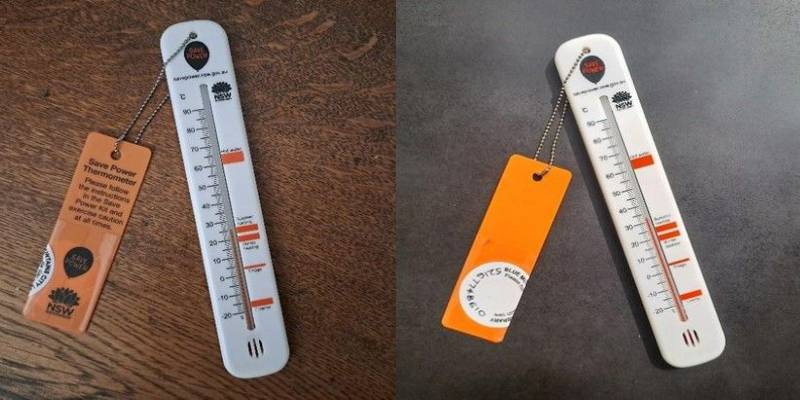
Thermometer reveals a nearly 10 degree difference between a western-facing room and an internal room on an Autumn day.
My daughter’s favourite activity was finding draughts in our windows (as well as testing her own temperature and mine) with the infrared thermometer. Although many of these windows already had draught tape, the thermometer revealed that most of the tape had worn through and needs replacing.
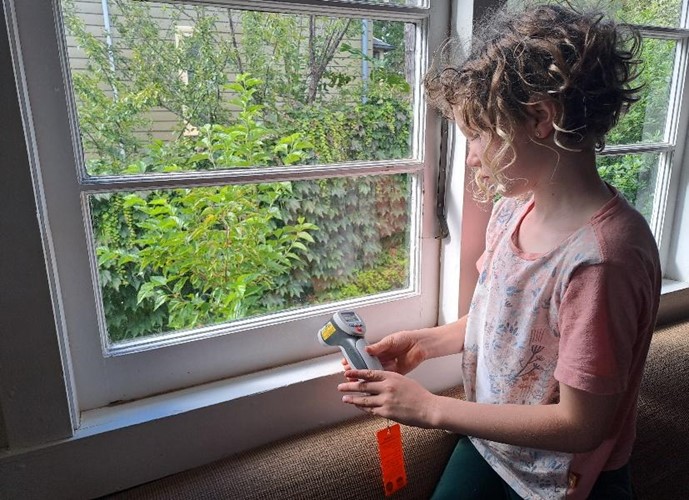
Nahla watching the temperature jump around on the infrared thermometer due to a window draught (on a day with very little wind).
Borrowing the ‘My Energy and Water Saver’ kit was a practical way of reassessing our electricity and water consumption habits, and it made the responsibility of household emissions more real and easily grasped for both the kids and the adults of our little abode.
Needless to say, the TV is no longer on standby and when my son forgets to turn off his bedside lamp, my daughter is quick to pull him up on it (“Leo, you left your lamp on, AGAIN!”).
If you’d like to understand your energy and water habits more comprehensively and make changes to reduce your emissions, I highly recommend borrowing this kit. You can also give feedback about your experience and tips for improvement at yoursay.bmcc.nsw.gov.au/my-energy-and-water-saver-kit.
Take Action:
- Borrow a ‘My Energy and Water Saver’ kit from your local Blue Mountains library.
- Use the tools to assess your home for energy and water efficiency and make changes like turning devices off at the switch, applying draught tape to your windows and changing your shower head for an improved flow rate.
- Get more tips for improving your energy efficiency at https://www.climatecouncil.org.au/top-tips-improve-home-energy-efficiency/
- Share this article with friends and family to help them save energy, water and money.
Share this article:
This story has been produced as part of a Bioregional Collaboration for Planetary Health and is supported by the Disaster Risk Reduction Fund (DRRF). The DRRF is jointly funded by the Australian and New South Wales governments.
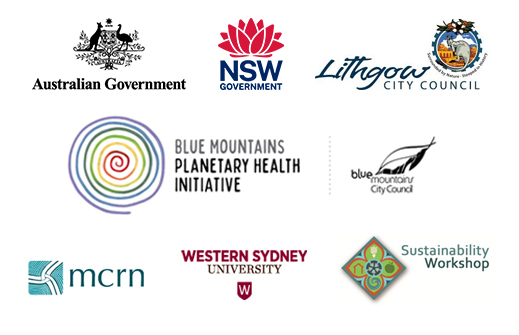
More from around the region
As 190 countries gather for the @cop16colombia UN Biodiversity Summit, to focus on how we can protect the world’s flora and fauna, we’d like to thank all those local individuals and organisations dedicated to the same goal who came together for World Animal Day at the Blue Mountains Planetary Health Centre on Saturday 5 October. They offered ways for everyone to learn more and take action. From the Blue Mountains Bird Observers, who led over 40 people on a guided Breakfast with the Birds walk, to many others who offered information stalls, talks, workshops, a Wild Life exhibition, live music, plant-based food and hands-on Bushcare. We also launched the Community Plant Based Cooking Project with the first class to be held on Saturday 9 November at @roseyravelstonbooks in Lawson. Places are limited. Learn more here: https://plantinspired.com.au/
#worldanimalday #biodiversity #plantbased #planetaryhealth #bluemountains #katoomba
Did you know that old lino, window putty, and adhesive can contain asbestos? Yesterday the Asbestos & Hazardous Materials Management Conference kicked off with a pre-conference workshop at the Blue Mountains Planetary Health Centre. It included hands-on `spot the asbestos` and asbestos sampling sessions. This year`s theme is `Working together for a safe and healthy future`. #asbestos #hazardousmaterials #conference #planetaryhealth #bluemountains #katoomba
A huge thank you to Josh Logan from Logan Signs, Lithgow, for installing our Circular Water Signage in time for our World Animal Day Celebration today at the Blue Mountains Planetary Health Centre (33-39 Acacia St Katoomba). We have a full program of events with lots of information on how to prepare for the summer ahead and how to create urban areas that help us share our home respectfully with all species. It will be a fun family day too with storytime, craft and live music for kids! (Link in profile) #worldanimalday #planetaryhealth #familyday #katoomba #bluemountains
And our Wild Life exhibition is now up for World Animal Day tomorrow at the Blue Mountains Planetary Health Centre. Photographs by Warren Hinder, Merryl Watkins, Holly Kent and Tracy Burgess. Check out all the other events from stalls, talks, possum box demo, kid`s craft and animal storytime, plant based food and live music to Bushcare. @33-39 Acacia St Katoomba Link in profile. #planetaryhealth #worldanimalday #katoomba
Join the Blue Mountains Planetary Health Initiative at World Animal Day this Saturday 5 October for a discussion on the history of the Plant Based Food Movement in Australia and a discussion of exciting contemporary trends. It will be followed by a Plant Based Cheese Degustation to launch the Plant Inspired Community Cooking Project. This will be a series of cooking classes to introduce the community to plant based cooking techniques. The event is free but places are limited so bookings essential (link in profile): https://bit.ly/3Bzbwhu
#plantbasedcooking #worldanimalday #bluemountains #katoomba #planetaryhealth #communitycooking
We share the Blue Mountains with so many extraordinary beings but have you seen them and do you know their names? Do you know the difference between a Royal Spoonbill and an Eastern Shrike-tit, or the difference between a bandicoot and an antechinus? Come and check out our Wild Life Exhibition at World Animal Day this Saturday to learn more from the stunning photographs by Warren Hinder, Merryl Watkins, Holly Kent and Tracy Burgess. There will be also be a Breakfast with the Birds at 8.30am, Animal Storytime and Craft for kids from 10am, stalls, talks, food and live music. The day is free but please book via Eventbrite to help us cater (link in profile): https://bit.ly/4eMhbz0 @bluemountainswalks @merrylwatkinsphotography @bestofbluemountains
#royalspoonbill #easternshriketit #wildlife #birdsofthebluemountains #bluemountains #katoomba #worldanimalday #biodiversity #planetaryhealth
To coincide with the first day of Bushfire Season we launched Air Watch at the Planetary Health Centre yesterday. For the last seven years Blue Mountains Unions & Community have been working tirelessly to ensure residents of the Blue Mountains and Lithgow are able to measure and track the quality of the air we breathe. The Blue Mountains Planetary Health Initiative has worked closely with them over the last year and now there are 20 PurpleAir monitors distributed throughout the Blue Mountains and Lithgow, including one at the Planetary Health Centre. You can now view real time air quality measurements at each of our local news sites and on the Purple Air Map https://map.purpleair.com We have 10 more sensors available, so if you’d like to install a sensor, members of BMUC will be at World Animal Day at the Planetary Health Centre this Saturday 5 October to take applications and share more information about the project. Bookings for World Animal Day here (link in profile): https://www.eventbrite.com.au/e/world-animal-day-promoting-respectful-cohabitation-tickets-1029328889417
It was a fabulous day yesterday as each speaker highlighted how critically important this project is: Dr Rosemary Dillon CEO of Blue Mountains City Council Trish Doyle MP Dr Jenna Condie from Blue Mountains Parents for Climate Dr Maggie Davidson, environmental scientist from Western Sydney University Matthew Riley, Director Climate and Atmospheric Science from NSW Department of Climate Change, Energy, the Environment and Water and Peter Lammiman and Ann-Maree McEwan from the BMUC’s Airwatch Committee.
@bluemountainsunionists @nswdcceew @bluemountainscitycouncil @westernsydneyu @trishdoylemp @parentsforclimatebluemountains #airqualilty #airqualitymonitors #bluemountains #planetaryhealth
Treat yourself this weekend with a fun-filled and informative World Animal Day event at the Planetary Health Precinct in Katoomba. As well as a Breakfast with the Birds, stalls and a possum box demonstration, there will be a fabulous wildlife exhibition with photos by Warren Hinder, Merryl Watkins, Tracy Burgess and Holly Jayne; live music with Mem Davis, Joe Flood and Duck Keegan; lots of fun for kids with Sharon Baldwin and Naomi Crew leading animal storytime and craft with Julie Refferty; delicious plant based, gluten and dairy free treats, pastries and donuts from Clean Cravings; a plant based cheese degustation and warming Dahl, rice roasted cauliflower with veggies, pakoras, tamarind chutney, and salad courtesy of Bibi’s Kitchen. Come and learn more about Blue Mountains Bird Observers, Blue Mountains Conservation Society, WIRES, Action for Animals Blue Mountains and Animal Sanctuaries, Wombat Rescue, the Women’s Shed, and Animal Welfare Laws in Australia.
Guest speakers throughout the day will include Elizabeth Ellis, lecturer and author of Australian Animal Law; Hal Ginges, a local lawyer and animal activist from Action for Animals who advocates for animal rights and raises money for sanctuaries; Mark Berriman who has been President of the Australian Vegetarian Society NSW since 1989, as well as Co-ordinator for Animal Liberation NSW, Director of the Natural Health Society of Australia and the World League for Protection of Animals; and Teya Brooks Pribac, a researcher in the area of animal studies and the award-winning author of Enter the Animal. She’s also published Not Just Another Vegan Cookbook and will be sharing her culinary skills with the community in the Plant Inspired Community Cooking Project.
The event is free but please book your place to help us cater (link in profile): https://www.eventbrite.com.au/e/world-animal-day-promoting-respectful-cohabitation-tickets-1029328889417
#worldanimalday #plantbased #planetaryhealth #katoomba #bluemountains
We are so looking forward to kicking off World Animal Day Celebrations on Saturday 5 October with an 8.30am Breakfast with the Birds. Join Paul Nagle from the Blue Mountains Bird Observers on a guided bird walk around the Planetary Health Precinct visiting different habitats on the site to observe and talk about the birdlife that is resident and that visits the site. Binoculars are highly recommended.
World Animal Day will be an inspiring family day celebrating the extraordinary diversity of animals we share our world with! The theme is `Promoting Respectful Cohabitation`. Bookings for the Breakfast with the Birds (link in profile)
or here:
https://www.eventbrite.com.au/e/breakfast-with-the-birds-tickets-1028664983657
#birdlife #breakfastwiththebirds #katoomba #worldanimalday #bluemountains #planetaryhealth #respectfulcohabitation
We all need clean air to breathe, but how can we tell how clean our air is?
Thankfully the Air Watch subcommittee of Blue Mountains Unions & Community has worked for years to find ways to help us measure the quality of the air we breathe. Over the past year the Blue Mountains Planetary Health Initiative has worked with them to install Purple Air Quality monitors across our bioregion from Lithgow to the Lower Mountains. You can now view real time air quality on each of our Local News Sites!
Air Watch`s Purple Air quality monitors give the Blue Mountains` 78,000 residents, workers and 3 to 5 million/year visitors the power to make timely, informed decisions about their activities and health. It will also be a reliable source of data for the scientific community.
To coincide with the start of the Bushfire Season on Tuesday 1 October, we`re inviting the whole community to join us to launch Air Watch Blue Mountains and Lithgow at the Planetary Health Precinct. If you`d like to join us book a place here https://bit.ly/4dp2qko (link in profile)
#airquality #purpleair #bluemountainsunionscouncil #planetaryhealth #bluemountains #katoomba #bushfireseason


